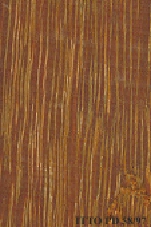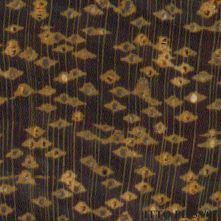
KEMPAS (Koompassia malaccensis)
Trade Name
Kempas
Scientific Name
Koompassia malaccensis Maing.
Family
LEGUMINOSAE
Common Names
Toealang ajam; Thongbeng; Tanggaris; Pa; Oempas; Njari; Mengris; Menggaris; Kampas; Garis; Enggaris; Toemaling (Indonesia); Kempas (United Kingdom); Kempas (Malaysia); Kempas (Sarawak); Menggris (Sarawak); Menggeris (Indonesia); Yuan (Thailand); Kempas (Papua New Guinea); Impas (Sabah)
Description Of The Tree
Botanical Description
It is a very large tree up to 60 m tall with columnar bole on average 60 cm in diameter but sometimes up to 210 cm, and large buttresses.
Natural Habitat
This very large tree is found in freshwater peat-swamp forest, usually below 150 m, but it is reported up to 600 m of altitude.
Natural Distribution
It spread mainly in Malaysia and Indonesia; throughout lowland forests in rather swampy areas and also on hillsides.
Wood Identification
Anatomic Description Of Wood
Wood diffuse porous. Tangential diameter of vessel lumina 200 micras or more (large). Tyloses common. Vessels per mm2 5 to 20. Simple perforation plates. Intervessel pits large, 10 micras or more. Paratracheal axial parenchyma scanty and/or vasicentric. Occasionally prismatic crystals in chambered axial parenchyma cells and/or in fibers. 5 to 8 cells per parenchyma strand. 4 to 10 rays per mm (medium). Body ray cells procumbent with mostly 2 to 4 rows of upright and/or square marginal cells (Kribs-II). Septate fibers present. Fibers with simple to minutely bordered pits.
-
 Wood Macro Photo Radial Plane
Wood Macro Photo Radial Plane
-
 Wood Micro Photo Of Transversal Section
Wood Micro Photo Of Transversal Section
Availability
Cites Status
Unrestricted
General Wood Description
Color
The sapwood is light yellowish to white, clearly differentiated. The heartwood is pink when fresh, darkens to light orange-red to deep brown.
COLOR INDEX (1=Black, 7=Light yellow,white)
4
Grain
The grain is reported to vary. It is straight, occasionally interlocked or wavy.
Texture
It is fairly coarse.
Natural Durability
The heartwood is durable in temperate climates, but in tropical climates it is moderately durable.
Natural durability index (1= Very high durability, 7=Vey low durability)
4
Silica Content
Silica Content: It is reported to contain 0.1% silica. Silica Value: 0.1
Resistance To Impregnation
This species can be impregnated fairly easily.
Wood Physical Properties
Basic Density or Specific Gravity (O.D. weight/vol. green) (g/cm³)
0.79
Air-dry Density (Weight and volume at 12%MC) (g/cm³)
0.91
Total shrinkage Tangential (Saturated to 0%MC) (%)
6.6
Total shrinkage Radial (Saturated to 0%MC) (%)
4.8
Drying Defects
Ease of Drying: The wood air dries readily without much degrade. Boards 25 mm thick can be kiln dried to 12% moisture content in about 2 days. Drying Defects: Kiln drying is reported to be good, but occasional end-splitting and twisting may occur. Kiln Schedules: A temperature of 60 to 70 degrees gives good results. A high-humidity treatment is recommended after drying.
Recommended Dry Kiln Schedule
UK-E; US-T6-D2
Dimensional stability ratio (Total Tangential Shrinkage %/Total Radial Shrinkage %)
1.4
Wood Chemical Properties
Wood Mechanical Properties
Bending Strength (MOR),12%MC (kgf/cm²)
1433
Stiffness (MOE) 12%MC (kgf/cm²)
192600
Compression parallel to fiber 12%MC (kgf/cm²)
740
Shear strength radial 12%MC (kgf/cm²)
163
Janka hardness (side) 12%MC (kgf)
761
Workability
Sawing
Sawing of this wood is reported to be fair to difficult.
Rotary Veneer Cutting
Good veneer of 1.5 mm thick can be made at a peeling angle of 92 degrees without pretreatment.
Sliced Veneer
Good veneer of 1.5 mm thick can be made at a peeling angle of 92 degrees without pretreatment.
Blunting Effect
Blunting of saw-teeth is moderate to severe.
Machining
It is somewhat difficult to machine and turn due to the interlocked grain and fibrous texture.
Planing
When planing, the cutting angle should be reduced to 20 degrees to avoid tearing.
Turning
30
Boring
It is difficult to bore.
Nailing
This wood is difficult to nail. Pre-boring is recommended.
Finishing
Filling is advisable.
Staining
It has a good staining.
Polishing
It has a good polishing.
REFERENCED USES
End Uses Summary
EXTERIOR GENERAL, bridges, poles, crossties, HOUSING GENERAL, beams, joists, boards, flooring, frames, FURNITURE AND CABINETS, PLYWOOD AND VENEER, TURNING, SPORTS, TOOLS, tool handles, agricultural tools, PACKING, CONTAINERS, cooperage, truck bodies, truck flooring, NAVAL CONSTRUCTION
Exterior General
- 1 - Tabela de resultados de ensaios fisicos e mecanicos
Bridges
- 2 - 25 madeiras da amazonia de valor comercial, caracterizacao, macroscopica, usos comuns e indices qualificativos
Poles
- 3 - Estudo dendrologico e determinacao das caracteristicas fisicas e mecanicas do genipapo (Genipa americana)
Crossties
- 8 - Maderas latinoamericas. III, Podocarpus standleyi ,Podocarpus oleifolius, Drims granadensis, Magnolia poasana y Didymopanax pittieri
General Housing
- 10 - Silica in Timbers
Beams
- 11 - Prospect: The wood database
Joists
- 12 - Tropical timbers of the world. Part I-Tropical American Species
Boards
- 13 - Dry kiln schedules for commercial woods. Temperate and tropical. Section III. Latin American (Mexico, Central, and South America) Woods–Conventional Temperatures
Flooring
- 14 - Handbook of Hardwoods
Frames
- 16 - Woods of the World
Furniture Cabinets
- 21 - Tropical timbers of the world. Part III-Southeast Asian and Oceanian Species.
Panels, Veneers
- 25 - Directory of Timber Trade Malaysia
Turning
- 30 - Embassy of Honduras in Japan
Sports
- 38 - Annual Review and Assessment of the World Timber Situation 1998-ITTO
Tools
- 42 - Utilización Industrial de Nuevas Especies Forestales en el Perú.
Tool Handles
- 43 - Maderas de Bolivia (Características y Usos de 55 Maderas Tropicales)
Agricultural Tools
- 44 - Atlas of Peruvian Woods
Packing
- 45 - Recopilación y Análisis de Estudios Tecnológicos de Maderas Peruanas
Containers
- 50 - Properties of imported tropical woods
Cooperage
- 51 - Recopilacion de propiedades mecanicas de maderas creciendo en Chile
Truck Body
- 53 - Timbers of the New World
Truck Flooring
- 54 - Bulletin of the Government Forest Experiment Station N.157: Identification of Tropical Woods
Shipbuilding
- 55 - Tropical Timber Atlas of Latin America
Please Provide Information To View Producer Information